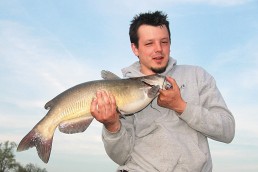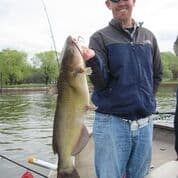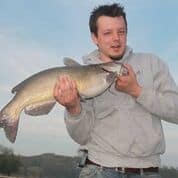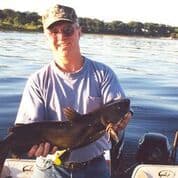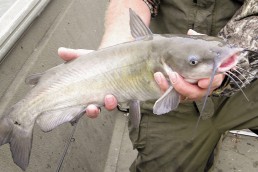Controlled Drifting and Trolling for Michigan Catfish
SHARE THIS POST
The early morning silence was broken by the sound of a rod bouncing in the rod holder. The first cat of the day was just a small 15-incher. By the time that fish was released, a rod buckled over and the tip was under water. And after a true dogfight, with line being pulled and the fish going in every direction but up, a dandy 12-pound fish was boated.
Often, a big cat acts like a monster bluegill on steroids mixed in with the determination of a smallmouth bass. They fight, they pull and they circle the wagon, creating some exciting moments when you still have a few rods in the water.
I like covering water in a “Huckleberry Finn” mode. Turn the boat sideways and drift with the current. We do the same in a lake. Holes and deep runs hold most of the fish and the deep slots near the channel, or often, the channel itself is excellent. Lakes have these specific areas, depending on the season, and are often overlooked by anglers.
In a river, you can slip with the current much like a steelhead or walleye angler. Or, you can turn the boat sideways. I prefer sideways; you cover a lot more water and netting a fish is much easier. Turning sideways allows more rods to be used without the fear of tangling. The trolling motor is only used to “push” or “pull” the boat away from the shoreline. If you get too close to the shoreline, just burp the trolling motor so that your rod is running a few feet from the bank.
On any given drift, you will need to tweak the boat in or outward a few times. We point the bow in the direction that we most often need to go on a drift.
Many times when working a weedline or the old river channel, the wind pushes you in a goofy manner. After one drift you should have which direction figured out that the trolling motor needs to face. Throwing out a drift sock or using your main engine as a rudder will dramatically alter the course and position of the boat too. By all means, use the outboard as a rudder.
There will be plenty of times on a lake or reservoir that the wind just plain will not accommodate a drift. Your trolling motor becomes crucial. I also use a Minn Kota I-Pilot remote. With an auto pilot mode, you can run an exact line, record it and duplicate it all day long. You can adjust the speed to match the conditions too. An auto pilot trolling motor will bring you back to the same spot, and when a run is complete, turn the boat around and do it all over again. If you do not have an auto pilot then I would suggest buying 6-12 marker buoys. Run your outboard slowly so you can trace out the route you want to fish. Run your trolling motor to keep you within the markers. I use floating markers all of the time. I know—some of you are shaking your heads wondering what is the GPS for. I mark my waypoints and such, but when drifting or trolling, nothing is as easy and fast as a marker. Plus, when you have another angler in the boat they can also spot your markers and assist in directions or adjusting the boat.
We will mark key features in a river or a lake with the markers, setting them a safe distance from where we want the boat to run. Running over a marker is not a good idea, and when the day is complete, you can then mark up your graph with the icons and label them for the next time out.
Drifting or trolling along a weed bed offers multiple depths to fish. We run one rod tight to the weedline and stagger the rest. Sometimes, one rod will run in 8 feet of water while the outside rod is running in 30 feet—and duplicate your patterns.
Rod holders are critical. We run 4 to 6 rods, and each rod is placed into a rod holder. I currently use the Driftmaster Rod Holders. They are the same holders that I employ when spider-trolling for panfish.
Are you enjoying this post?
You can be among the first to get the latest info on where to go, what to use and how to use it!
When you are drifting in a river, pay close attention to the location a fish hits. Some days they are in a deep hole, and other days they might use a long run. Once you pick up a fish or two, duplication is simple.
On a lake, we search out the forage. Often, starting near the deep side of a weedline is perfect. Cats are hungry and will be close to the forage. A sharp break or drop-off into deep water that is close to a weedline or food shelf is desired.
During midday we target the old riverbed. On one of my favorite inland lakes, my deepest channel cat came from 83 feet of water. We were working the old riverbed, starting in 86 feet of water and sliding up to 60. We would run a section a few times and then move down 50 yards and repeat it. During the dog days of the summer, we fish the old river channels in many of the drowned river basins.
Drift socks are used on both rivers and a lake when the speed is too fast and for guidance. Placing a drift sock on the tip of the bow or alongside of the motor will change the angle of the drift. Slow is the key; most often between .3 mph and .7 mph. Your drift socks will greatly reduce your speed.
Strikes are fast on slow-moving baits. Catfish have only seconds to decide if the aroma or scent is enticing. A meal that is slowly bouncing along the bottom results in a fast hit or at least a quick grab. Rarely will you need to feed line to moving cats.
Anglers living along any of the Great Lakes have it easy. Each spring, and perhaps lasting into late June, we enjoy a large run-up of catfish into the rivers or the drowned river mouth lakes. Catfish of all sizes run up these waters to spawn. Muskegon Lake, Holloway Reservoir, the Grand River, White Lake and the Kalamazoo River are but just a few of the good catfish waters in Michigan. Check the master angler list and you will find plenty of good waters to fish.
Cut bait can be small bluegills, pieces of a sucker or sheepshead—it really doesn’t matter. Cut the chunks small, and step it up to larger chunks or even that very small, alive bluegill, if needed. We soak all of our cut bait in anise oil, but I am sure other scents would work as well. Soak and freeze them in small plastic bags.
Chicken or beef liver is a great option and can often be bought or given to you from your local butcher. A third option is a hot dog. Nuke the hot dogs for 30 to 40 seconds, just long enough to toughen up the skin. Then cut into 1- or 2-inch chunks. Anise-soaked, microwaved hot dogs produce the most fish, but not always the largest fish for us. If you plan ahead a day or two, then soak the cut baits or the hot dogs in the anise oil. Mix the anise oil, say three parts water to one part anise oil. No need to scent the bloody liver; it works great on its own. We then place the bait onto the circle hooks. Circle hooks do a nice job of hooking the fish in the corner of the mouth. Most of our fish hook themselves and are easy to unhook and release. Remember that you are catfishing, not going for walleyes, so use large hooks. Our smallest might be a number 1, but most often we end up with a number 2/0 or a 3/0 hook. Two pieces of hot dog or one large chunk works well on the larger hooks.
A floating jig head is used when a dash of collar is needed or when dealing with short grass or moss on the bottom. We use floating jig heads a lot when fishing depths of 40 to 70 feet. Look for the largest floating jig heads on the market.
Drifting or trolling will put more catfish into the boat. With proper boat control, this is the easiest and most productive way to land channel catfish. One outing and you will have it mastered.
MWO
SHARE THIS POST
Did you enjoy this post?
You can be among the first to get the latest info on where to go, what to use and how to use it!
Jack Payne
Jack Payne is an accomplished angler and hunter who enjoys teaching others as much as learning from others. Seminar speaker, outdoor photography enthusiast, hunter safety instructor and volunteer at many events for both kids and adults as an instructor.
